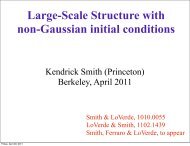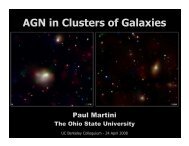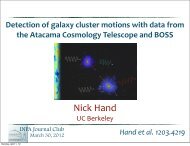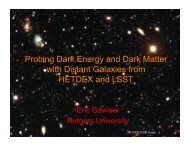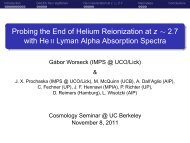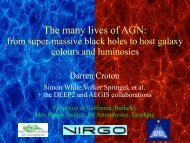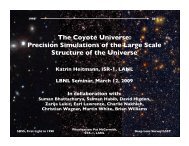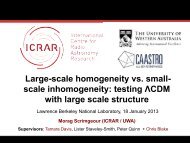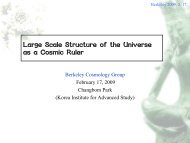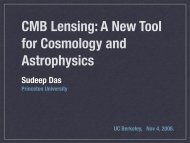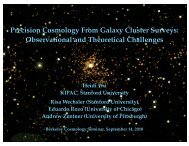The WiggleZ Dark Energy Survey - Berkeley Cosmology Group
The WiggleZ Dark Energy Survey - Berkeley Cosmology Group
The WiggleZ Dark Energy Survey - Berkeley Cosmology Group
You also want an ePaper? Increase the reach of your titles
YUMPU automatically turns print PDFs into web optimized ePapers that Google loves.
<strong>The</strong> <strong>WiggleZ</strong> <strong>Dark</strong> <strong>Energy</strong> <strong>Survey</strong><br />
• Large-scale structure survey covering SDSS-like<br />
volumes over a range of higher redshifts to z=1<br />
• Test the cosmological model in three ways :<br />
• (1) Use the baryon acoustic peak as a standard<br />
ruler to measure cosmic distances to z=1<br />
• (2) Map the growth rate of structure to z=1<br />
• (3) Use Alcock-Paczynski distortions to measure a<br />
non-parametric expansion history<br />
• Cross-check evidence for dark energy from SNe
<strong>The</strong> <strong>WiggleZ</strong> <strong>Dark</strong> <strong>Energy</strong> <strong>Survey</strong><br />
• 1000 sq deg , 0.2 < z < 1.0<br />
• 200,000 redshifts<br />
• blue star-forming galaxies<br />
• Aug 2006 - Jan 2011
<strong>The</strong> <strong>WiggleZ</strong> <strong>Survey</strong> (observational) Team<br />
Swinburne : Chris Blake , Carlos Contreras , Warrick Couch , Darren<br />
Croton , Karl Glazebrook , Tornado Li , Greg Poole , Emily Wisnioski<br />
University of Queensland : Tamara Davis , Michael Drinkwater<br />
Sarah Brough (AAO) , Matthew Colless (AAO) , Scott Croom (U.Syd.) ,<br />
Ben Jelliffe (U.Syd.) , Russell Jurek (ATNF) , Kevin Pimbblet (Monash) ,<br />
Mike Pracy (UNSW) , Rob Sharp (ANU) , David Woods (UBC)<br />
GALEX team : Karl Forster , Barry Madore , Chris Martin , Ted Wyder<br />
RCS2 team : David Gilbank , Mike Gladders , Howard Yee
<strong>The</strong> <strong>WiggleZ</strong> <strong>Survey</strong> (cosmology analysis) Team<br />
Swinburne: Chris Blake , Carlos Contreras , Felipe Marin , Greg Poole<br />
U. of Queensland: Tamara Davis , David Parkinson , Signe Riemer-Sorensen<br />
University of Western Australia: Morag Scrimgeour<br />
DARK / <strong>Berkeley</strong>: Berian James
<strong>Survey</strong> comparison
<strong>Survey</strong> comparison
<strong>Survey</strong> design<br />
• Follow up UV-selected sources<br />
from GALEX imaging<br />
• Colour cuts select highredshift<br />
galaxies<br />
• Star-forming galaxies : redshifts<br />
from emission lines, SFR<br />
10-100 solar masses per year<br />
•<br />
Short 1-hr exposures -<br />
maximize numbers with 70%<br />
redshift completeness
<strong>Survey</strong> design
<strong>Survey</strong> design
Redshift distribution
Target Galaxy selection targets<br />
(Credit: Mike Pracy)
<strong>The</strong> baryon acoustic peak<br />
Baryon Acoustic Oscillations 5<br />
Fig. 3.— As Figure 2, but plotting the correlation function times<br />
s 2 . This shows the variation of the peak at 20h −1 Mpc scales that is
<strong>The</strong> baryon acoustic peak in <strong>WiggleZ</strong>
<strong>The</strong> baryon acoustic peak in <strong>WiggleZ</strong><br />
arXiv:1108.2635
BAO Hubble diagram<br />
arXiv:1108.2635
<strong>The</strong> 6-degree Field Galaxy <strong>Survey</strong><br />
(s)<br />
!<br />
0.05<br />
0.04<br />
0.03<br />
0.02<br />
0.01<br />
0<br />
-0.01<br />
D(z=0.1) = 456 +/- 27 Mpc<br />
6dFGS data<br />
best fit<br />
2<br />
" mh<br />
= 0.12<br />
2<br />
" mh<br />
= 0.15<br />
no-baryon fit<br />
-0.02<br />
20 40 60 80 100 120 140 160 180 200<br />
-1<br />
s [h Mpc]<br />
Measurement of baryon acoustic<br />
peak in local Universe<br />
See paper by Florian Beutler !<br />
]<br />
-1<br />
Mpc<br />
-1<br />
[km s<br />
0<br />
H<br />
70<br />
60<br />
50<br />
H0 = 67.0 +/- 3.2 km s -1 Mpc -1<br />
6dFGS<br />
2<br />
! mh<br />
prior<br />
2<br />
6dFGS + ! mh<br />
prior<br />
0.15 0.2 0.25 0.3<br />
! m<br />
0.35 0.4
<strong>The</strong> Comparison dark energy of BAO puzzle statistics in <strong>WiggleZ</strong><br />
Correlation function<br />
Power spectrum<br />
Band-filtered<br />
correlation function<br />
arXiv:1105:2862
Comparison of BAO fitting techniques<br />
arXiv:1105:2862
Cosmological parameter fits<br />
arXiv:1108.2635
Cosmological parameter fits<br />
Cosmological<br />
constant<br />
arXiv:1108.2635
Cosmological parameter fits<br />
Spatially-flat cosmological<br />
constant model<br />
arXiv:1108.2635
Stacking the BAO measurements!<br />
5-sigma detection<br />
significance<br />
arXiv:1108.2635
Redshift-space distortions<br />
4<br />
• Does a cosmological model produce self-consistent<br />
cosmic growth and expansion histories?<br />
coherent flows<br />
virialized motions<br />
4. RESULTS: I. 2MRS VELOCITY FIELD AND<br />
COMPARISON WITH MEASURED DISTANCES<br />
In a reconstruction of the velocity field using<br />
MAK based on priors, we fix Ωm = 0.258 as indicated<br />
by WMAP5 results and set the bias parameter<br />
(Kaiser & Lahav 1989) to 1 using 2dF<br />
and SDSS/WMAP results (Dunkley et al. 2008;<br />
Tegmark et al. 2004; Cole et al. 2005). <strong>The</strong> velocity<br />
of each galaxy in 2MRS is reconstructed using these<br />
parameters. <strong>The</strong> first approach is to measure the<br />
3,000 km s −1 bulk flow in both cases as it is done<br />
in Section 4.1. In a parallel approach, discussed in<br />
Section 4.2, we leave Ωm free and then constrain<br />
its value by maximizing the correlation between the<br />
reconstructed and observed peculiar velocities. <strong>The</strong><br />
2MRS velocities are reconstructed using a uniform grid<br />
of size 130 3 sampling a cubic volume of 260 3 h −3 Mpc 3<br />
as shown in Fig. 2. <strong>The</strong> motion of the Local <strong>Group</strong> is<br />
obtained using an interpolation based on the adaptive<br />
weighting of the peculiar velocities of the objects that<br />
lie within 4-5h −1 Mpc from us (method detailed in<br />
Appendix C). We have checked that increasing the<br />
reconstruction resolution does not significantly change<br />
the reconstructed velocities.<br />
−1
Redshift-space distortions<br />
infalling<br />
galaxies<br />
observer<br />
virialized<br />
motions<br />
coherent<br />
flows
Redshift-space distortions in <strong>WiggleZ</strong><br />
arXiv:1104.2948
Growth rate measurements from <strong>WiggleZ</strong><br />
arXiv:1104.2948
Growth rate measurements from <strong>WiggleZ</strong><br />
arXiv:1104.2948
Growth rate measurements from <strong>WiggleZ</strong><br />
arXiv:1104.2948
Density and velocity power spectra in <strong>WiggleZ</strong><br />
Exploit the different angular dependences ...<br />
Determine velocity power spectrum: Determine stochastic bias:<br />
arXiv:1104.2948
Alcock-Paczynski measurement<br />
True appearance of<br />
cluster of galaxies :<br />
Observer’s line of sight<br />
Appearance in assumed<br />
cosmological model :
Alcock-Paczynski measurement in <strong>WiggleZ</strong><br />
arXiv:1108.2637
Alcock-Paczynski measurement in <strong>WiggleZ</strong><br />
Measurements of DA H marginalized over growth<br />
arXiv:1108.2637
Alcock-Paczynski measurement in <strong>WiggleZ</strong><br />
Supernova distance-redshift relation<br />
arXiv:1108.2637
Model-independent cosmic acceleration<br />
• With current data, the accelerating expansion can<br />
only be established by assuming a cosmological model<br />
• But, the importance of dark energy lies in the fact<br />
that we don’t know what this model should be!<br />
• Can we demonstrate the acceleration modelindependently<br />
or non-parametrically?<br />
• Need to measure the Hubble parameter as a function<br />
of redshift :
Non-parametric expansion history<br />
arXiv:1108.2637
Non-parametric expansion history<br />
Reconstruction of H(z) using<br />
Shafieloo et al. method<br />
arXiv:1108.2637
Non-parametric expansion history<br />
arXiv:1108.2637
Neutrino mass limit from <strong>WiggleZ</strong> P(k)<br />
Riemer-Sorensen et al.<br />
arXiv:1112.4940<br />
Combined <strong>WiggleZ</strong> power<br />
spectrum dataset compared<br />
to various models :<br />
Probability histogram for the<br />
k 1.6 k Pconv(k) 1.6 Pconv(k) Relative probability<br />
140<br />
120<br />
100<br />
80<br />
60<br />
40<br />
0.25<br />
0.20<br />
0.15<br />
0.05<br />
0.1 0.2 0.3 0.4 0.5<br />
k [h Mpc −1 0.1 0.2 0.3 0.4 0.5<br />
k [h Mpc ]<br />
−1 ]<br />
<strong>WiggleZ</strong>+WMAP+H0+SDSS-BAO:<br />
0.29 eV (95% limit)<br />
sum of neutrino masses : 0.10<br />
<strong>WiggleZ</strong> + WMAP7 :<br />
0.60 eV (95% limit)<br />
0.00<br />
0.0 0.2 0.4 0.6 0.8 1.0 1.2 1.4<br />
!m " [eV]
Transition to cosmic homogeneity<br />
Scrimgeour et al.<br />
(submitted)<br />
Measurement of the correlation dimension N(
Other analyses in progress ...<br />
• Cosmo-MC module for P(k) and data release<br />
• Limits on modified gravity theories<br />
• Higher-order clustering (non-Gaussianity , skewness)<br />
• BAO reconstruction and 2D fitting for DA(z) / H(z)<br />
• Clusters and voids<br />
• Cosmic topology (genus)<br />
• Turnover in power spectrum (early-universe physics)
Summary of results from <strong>WiggleZ</strong><br />
• Baryon acoustic peak detected at ~3-sigma<br />
significance and measures cosmic distances to z=0.8<br />
• <strong>WiggleZ</strong> gives most accurate growth measurement,<br />
extending previous work to higher redshift<br />
• Alcock-Paczynski effect allows direct reconstruction<br />
of H(z) at high redshift<br />
• G.R. + Lambda models remain a good fit<br />
• If dark energy behaves as Lambda, what is its physics?




